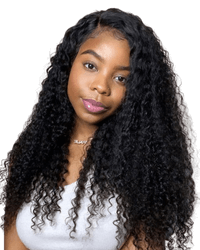There are days you’ll notice your locs are not as thick as before. This is nothing good to anticipate or be comfortable with. The discovery should sound like a ticking alarm in your mind.
You certainly ought to step beyond your comfort zone and find out the root cause of the thinning before it’s too late. If the situation gets out of hand, you’ll lose your hair, my dear.
Given that it was completely unexpected, it could be challenging to pinpoint what prompted your thin locs. This post will open your eyes to the precise reason behind the issue.
Reasons for Locs’ Thinning
Identifying what made your locs thin out is important. Through that, you’ll be able to determine the most suitable antidote for the problem. Remember, how the locs thinned in another person may not be the same for you because of various differences.
1. Over-manipulation
Locs can be healthily thin depending on the loc size you choose. We desire thin locs for our hair to look fuller. Then easily forget that the loc is very fragile when thin and chances of breakage are high.
Things start going awol when you decide to style the hair every now and then. The frequency triggers thinning of the locs, especially at the roots, owing to twisting, pulling, and manipulation. The more you switch up dreadlock styles, the more the thinning over time.
But that doesn’t mean thick locs are out of danger. They are vulnerable but less vulnerable than thin-sized locs because they tend to be stronger. But once thinning starts, time is what makes the difference, as thick locs will take longer to give into breakage.
2. Tight Hairstyles
Tight hairstyles are a great recipe for baldness or thin spots along the loc’s dimension. Undeniably, tight hairstyles give a neat look. Though beyond the great appearance, there’s an underlying havoc due to tension from the scalp and loc pulling.
The constant pulling tugs the scalp and eventually damages the hair follicles. When the follicles are damaged, hair growth slackens, resulting in weaker hair at the roots.
With the tightness still in the picture, the locs begin to thin within their structure and break in no time, the beginning of traction alopecia. If traction alopecia is not dealt with in its early stages, it could be irreversible. The hair may not regrow to restoration.
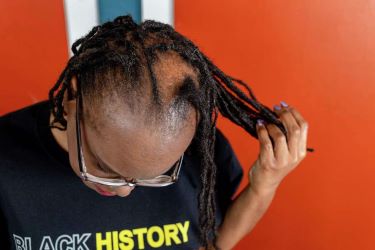
3. Improper Maintenance
Lack of proper maintenance suggests you threw caution to the wind. You no longer take care of your dreadlocks with the right products and regularly. The in-between waiting times are of great essence. Because if you fail to routinely maintain the dreads, you expose them to adverse conditions like thinning.
For instance, if you don’t oil the locs as required, they’d easily lack moisture, dry, and become delicate. Or if you clarify your locs less often, product buildup will form, accumulate and weigh down the locs. So, time is an inevitable factor in terms of loc maintenance and averting thinning.
When it comes to the products you use on them, they should be all-natural and residue-free. Heavy products overwhelm the hair with unneeded weight since they leave behind oily grime.
4. Coloring Your Locs
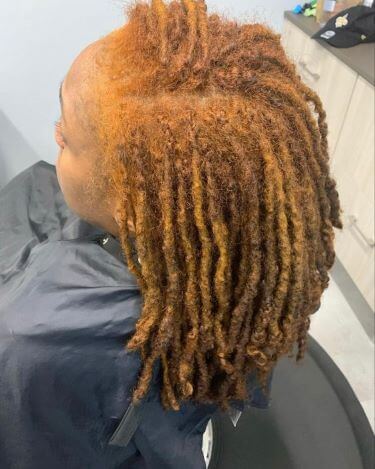
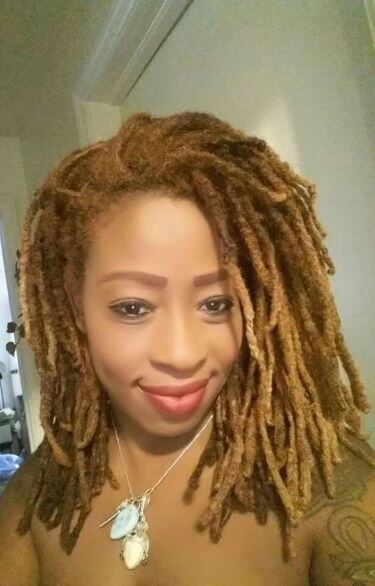
Also, I understand you love to color your locs to glow with a crisp, bright pigment. On the downside, bleaching, especially if done poorly in a bid to infuse the color, strips the hair of its protein. That further weakens the hair strands to become brittle and thin.
The situation gets worse if you bleach the locs repeatedly. Apart from protein, the hair loses essential fatty acids in the process, and this causes permanent damage. And the bleach also breaks down the hair cuticle, and moisture loss is inevitable, invoking dry, dull locs.
5. Nutritional Deficiencies
If your daily diet doesn’t contain healthy nutrients to keep the dreadlocks healthy, they will get impoverished. They’d later thin and, if not careful, fall out.
Your diet should be rich in proteins, vitamins, and minerals to steer hair growth. A balanced diet will not only promote overall health but also healthier, thicker tresses. Also, drinking a sufficient amount of water is significant in hydrating your hair besides your body.
6. Medical Prescriptions
Some medications may have hair thinning or hair loss as one of the side effects. The only way is to stop or avoid taking them depending on whether it has alternatives because some prescriptions may not have them. If you cannot avoid it, you can adjust the dose with the knowledge of your doctor.
The reason for the excessive hair loss is their toxicity to hair follicles. If you notice this could be the cause, talk to your doctor for better recommendations.
7. Psychological Stress
Sometimes, external factors may not be the problem, but surprisingly, your mental state is. Most people really underestimate the effects of stress.
If you experience severe stress, hair may start thinning, and you may see bald patches. It could even be after a stressful event such as a chronic illness or the death of a close family member. But mostly, thinning or hair loss due to stress is temporary, and once it goes away, hair begins to grow back to normal.
In some cases, extreme stress aggravates already-existing hair loss. It may not be the original cause that triggered the beginning of hair shedding.
8. Genetics (Hereditary Patterned Baldness)
Hair-thinning genes could be in your family. You may have inherited from your mother’s or father’s side, and it’s basically a natural condition. Most of the time, genetics influence loc thinning alongside other causative factors.
Unfortunately, hereditary hair thinning can not be prevented but can be controlled to happen slowly. And even if it starts happening, you cannot reverse it. Doctors’ medications, a good diet, supplements, and our suggested solutions will help slow it down.
9 Tips to Save Your Thinning Locs
If you notice your thinning locs, do not despair; remedies are available. With our solutions to every cause in place, you’ll secure your dreadlocks from succumbing to thinning out and falling off. The following tips will be effective whether they are thinning at the roots, midshaft, or loc ends.
1. Trimming
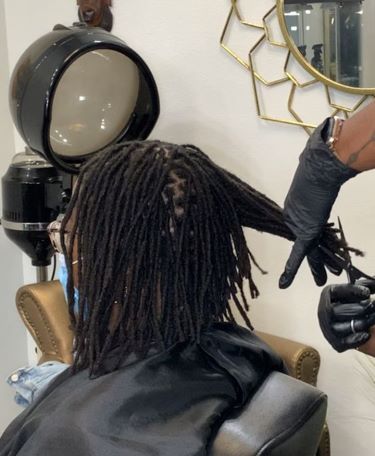
Trimming works if the dreads are thinning at a considerable length away from the scalp. It could be anywhere from the middle to close to the ends. Trimming is the best shot at getting yourself new hairstyles for your short locs if they get short after trimming.
You may find that the locs remain long even after trimming if you had super-long locs. If you go with this idea, ensure you’re ready psychologically because length is a treasure to some people.
And when trimming a few thinned locs, consider the length of the rest of the dreadlock strands. The length of all the locs should be uniform after trimming to look fine. However, it’s better to tie knots if thinning locs are few in number.
2. Tying a Knot
This option is lenient and more accommodating for dreadlocks wearers who value length. Or if only three or four dreadlocks have thinned but in different positions, it’s more reasonable to tie knots rather than trimming them. Similarly, it’s perfect for thinning spots close to the ends.
Your beautiful long locs remain intact by tying a knot at the thinning spot’s ends. Then palm roll gently to smooth the knotted section to be uniform with the loc itself.
3. Combining Locs
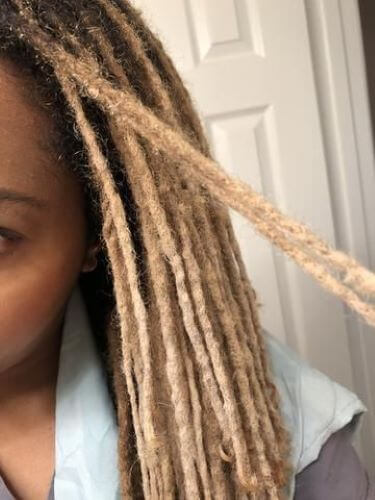
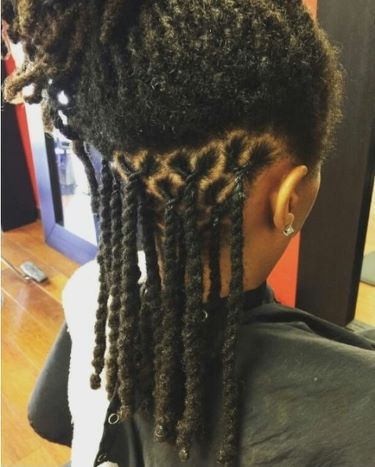
Honestly, skinny locs could use a little support from another surrounding skinny loc. If they are in even numbers, 2, 4, 6, or even 8 locs and neighboring each other, divide them in half and twist them. That is as long as their size after twisting is similar to the size of the other locs.
If their total number is odd, opt for 3-strand twists or braiding when combining them. The twist or braid pattern disappears with time, and the loc becomes an interlocked dreadlock. Take note of the fact that braid patterns take longer to fade away.
Alternately, you can palm roll them into a single loc while being careful not to overtwist.
4. Avoid Over-manipulation
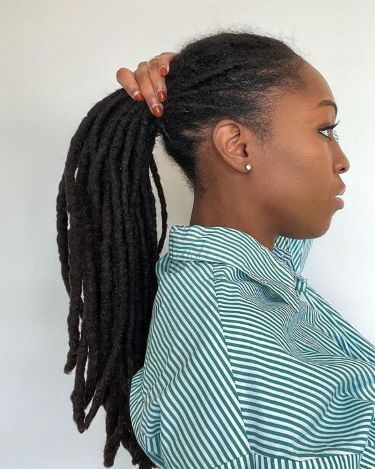
If styling was your go-to activity in less than 2-3 weeks, you’ll need to do that less often. In fact, mature dreadlocks can stay unstyled or retwisted for six months or more with the right care. You may think your hair is messy, but it’s a style on its own though not manipulative on the hair.
You can style your hair as you wish once your hair has recovered from thinning. But this time, you take into consideration hairstyles that do not pull your hair and scalp. And when twisting, be gentle enough to avoid overtwisting.
Avoiding over-manipulation extends to avoiding coloring your locs. Dyes and bleaches are good for color but harmful to your locs.
5. Healthy Hairstyles
These are hairstyles that do not pull or cause strain on your dreadlocks. In other words, avoid tight hairstyles, by all means, to speed up the recovery of your thinning hair. And after they get in good shape, refrain from returning to the old styling habits.
Consider allowing your locs to be freely down or in loose ponytails or buns to avoid pulling your edges. After tying your locs with a hair tie or bobble, loosen the tight strands to relax the scalp and the locs. You’d also be taking away the pain due to tightness, which may spur excruciating headaches.
6. Proper Care Routine
Now is the time to upgrade your care routine if it’s been missing very important elements. Of much priority is the products you use, as they’re the foundation of healthy and robust dreads. Ensure all the products in your care kit are specifically designed for locs.
Even if they are manufactured for locs, desist using products that are too heavy or greasy. The moisturizer should also be a water-based formula to adequately moisturize your locs.
If all your products are in check, stick to the correct timings between the applications. And don’t wait for longer periods between retwists for starter locs or locs in the budding phase.
7. Adding Hair Extensions
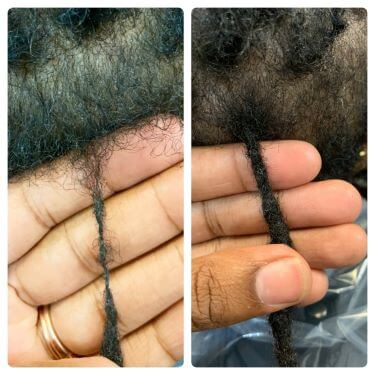
Reinforce the thin sections with dreadlock extensions as another way to repair them. The hair extensions add thickness to thinning locs to strengthen them and mitigate further thinning. Or you can choose to wrap the thin areas with strands of human hair, especially at the roots or the ends.
The wrapping at the roots enables flyaways to intertwine with the new hair growth. It helps bolster the loc strand to grow thicker and not fall off.
8. Staying Relaxed in Agitating Situations
That time between how you feel and how you react matters a lot. It’s human to feel anxious, angry, frustrated, or nervous. Handling these emotions at the right time puts stress under control.
Whenever you feel agitated, engage yourself in an activity that distracts your mind to keep you at ease. Train your mind to meditate to calm down and practice deep breathing exercises. You can watch comedies to laugh more, work out hard at the gym or get yourself in a yoga session.
Every person has a relaxing activity that works for them. Seek to find that which is fun and calming for you whenever stress flares up. Sometimes, walking away from the stress-inducing environment could be the solution.
9. Professional Consultation
Out here, there are professionals qualified to handle problems beyond your intervention. If your diet is malnourished or you’re a poor feeder, communicate with a certified dietician or nutritionist. They will provide recommendations for you to lead a healthy lifestyle.
However, it’s best to first talk to your loctician. They could identify the cause and sort it out if it’s nothing too serious. But if it’s wanting, they could refer you to bigger professionals.
Hair thinning can be so severe that only expert dermatologists can examine you. After a diagnosis, they’d be able to prescribe treatments specifically for your problem. They could be medications or surgeries in super-severe conditions.
Only dermatologists can tell if genetics play a big role in your loc thinning and hair loss. Or if it’s something else you or your loctician couldn’t discover.
Takeaway
Taking care of your dreadlocks is the most important to prevent thinning locs. If you can hinder their occurrence, thinning locs won’t be in your books. Pamper them with overwhelming love by hydrating and keeping them well-maintained.
Any other tips to secure locs from thinning? Mention them in a comment below.




